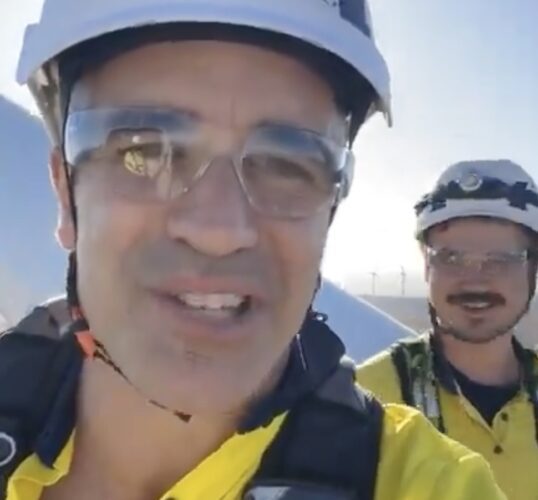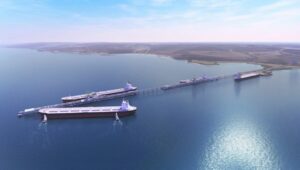The South Australia state government says it has fast tracked its target of “net 100 per cent” renewables to 2027 – rather than 2030 – as a result of the state’s new wind and solar developments and its ambitious hydrogen plans.
South Australia already leads the world with more 71 per cent (or 74 per cent according to government data) of its annual demand being met by wind and solar only over the last 12 months.
“Net” 100 per cent renewables, means producing enough wind and solar to meet the annual demand figure, although some excess wind and solar will be exported when not needed in South Australia, and electricity imported from other states at other times. Gas power will still be used at certain times.
“We must not rest on our laurels and we cannot afford complacency,” premier Peter Malinauskas said in a statement on Tuesday, soon after visiting the top of a wind turbine at the Lincoln Gap wind farm. “The time is right to recalibrate and set an even more ambitious target.

“The world is demanding that economies decarbonise to avoid the risk of catastrophic climate change. Our bountiful resources of wind and solar energy provide us the opportunity to seize the moment and produce what the world demands.“
South Australia has always had the most ambitious renewable energy targets in Australia, but the reality is that it has never set a target that it knew it couldn’t meet.
It has been clear for some time that the state would reach “net 100 per cent” renewables well before the deadline set by the previous Liberal government in 2020 (yes, the state has a remarkable amount of bipartisan support, because there is no local coal industry to capture the conservatives).
The Australian Energy Market Operator had predicted the target could be reached by 2026, and late last year the transmission company ElectraNet confirmed the “net 100 per cent” renewables target would be met several years early.
In its report, ElectraNet noted that wind and solar had met all the state’s demand on one quarter of all trading periods over the previous 12 months.
The faster uptake has been propelled by the growth of rooftop solar, and the construction of new utility scale projects, such as the 412 MW first stage of the Goyder South wind farm – the biggest in the state – and a slew of new big battery projects, including the Blyth battery that will help Goyder South supply “baseload renewables” to the giant Olympic Dam copper mine.
The reliability of the grid, and its ability to export and import more electricity when needed, is being enhanced by the construction of the new transmission link to NSW, Project Energy Connect, which should be operating in 2026 and will reduce the number of times and the volume of constraints on local wind and solar output.
South Australia will need a lot more wind and solar to meet its hydrogen targets, both for the state government owned 250 MW electrolyser to be built in Whyalla, and the 200 MW green hydrogen power plant being built alongside it to help meet peak demand.
A number of major companies are also looking at hydrogen production facilities in the Port Bonython precinct which will also require considerable amounts of new wind and solar capacity.
The state government says that under its plan, excess renewable energy generated from large-scale wind and solar farms will be stored and utilised to provide a consistent output of supply, providing additional grid stability for homes and businesses around the state.
“Wind and solar power is far cheaper than electricity generated by gas, so an increased proportion of renewables will push prices lower,” the government said in its statement.
“This will unlock the potential for mining, processing, and manufacturing to produce carbon-neutral goods for the world’s markets – driving SA prosperity.” It said this synergy between investment and renewables is already being borne out by the contract to supply BHP’s Olympic Dam mine.
The government stated noted that AEMO generation forecasts show electricity demand in South Australia economy growing from around 16,000 gigawatt-hours this financial year to nearly 23,000 gigawatt-hours in 2030-31.
“The bulk of the extra energy will be provided by renewables, with supply so plentiful that South Australia will be consistently a net exporter to the eastern states,” it says.
“The Malinauskas Government is confident our Hydrogen and Renewable Energy Act and positive attitude to investors will spur more renewables projects.
“At the same time, we have observed coal-fired power stations interstate becoming increasingly less reliable and owners making decisions to close them early.
“This will create demand from interstate for our clean, reliable power.”
South Australia’s push into high levels of wind and solar has delivered some notable outcomes. In 2023, there were 289 days in which renewables met all of the consumption demand of the entire state for part of the day, and rooftop solar alone has met all state demand on occasions, most recently on December 31.
“There is no doubt we will get to net 100 per cent renewables before 2030,” energy minister Tom Koutsantonis said a statement.
- “So we are doubling down on our ambition. We want to get there even sooner.
- “The global price shocks of 2022 proved that we must strengthen our own supply and resilience to external pressures.“







